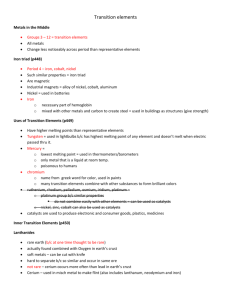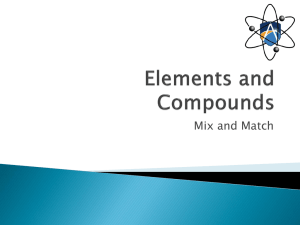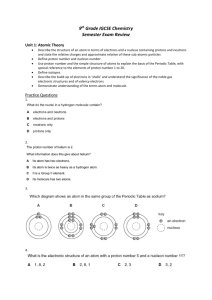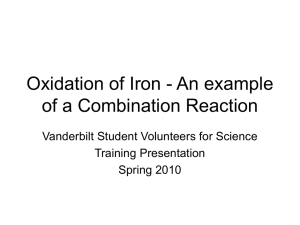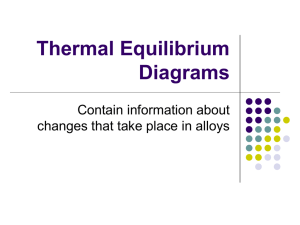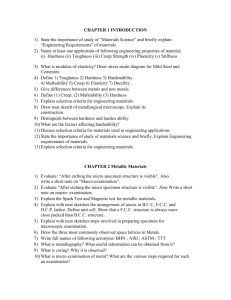Mikell P. Groover 2012 Chapter 6 METALS Multiple Choice Quiz
advertisement
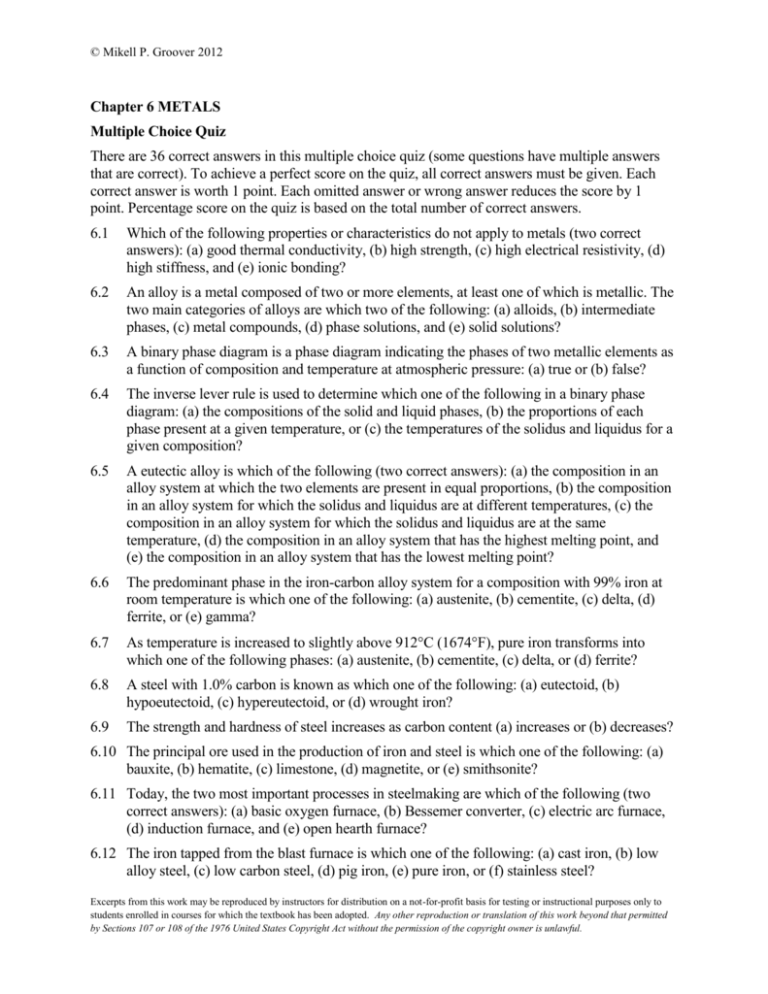
© Mikell P. Groover 2012 Chapter 6 METALS Multiple Choice Quiz There are 36 correct answers in this multiple choice quiz (some questions have multiple answers that are correct). To achieve a perfect score on the quiz, all correct answers must be given. Each correct answer is worth 1 point. Each omitted answer or wrong answer reduces the score by 1 point. Percentage score on the quiz is based on the total number of correct answers. 6.1 Which of the following properties or characteristics do not apply to metals (two correct answers): (a) good thermal conductivity, (b) high strength, (c) high electrical resistivity, (d) high stiffness, and (e) ionic bonding? 6.2 An alloy is a metal composed of two or more elements, at least one of which is metallic. The two main categories of alloys are which two of the following: (a) alloids, (b) intermediate phases, (c) metal compounds, (d) phase solutions, and (e) solid solutions? 6.3 A binary phase diagram is a phase diagram indicating the phases of two metallic elements as a function of composition and temperature at atmospheric pressure: (a) true or (b) false? 6.4 The inverse lever rule is used to determine which one of the following in a binary phase diagram: (a) the compositions of the solid and liquid phases, (b) the proportions of each phase present at a given temperature, or (c) the temperatures of the solidus and liquidus for a given composition? 6.5 A eutectic alloy is which of the following (two correct answers): (a) the composition in an alloy system at which the two elements are present in equal proportions, (b) the composition in an alloy system for which the solidus and liquidus are at different temperatures, (c) the composition in an alloy system for which the solidus and liquidus are at the same temperature, (d) the composition in an alloy system that has the highest melting point, and (e) the composition in an alloy system that has the lowest melting point? 6.6 The predominant phase in the iron-carbon alloy system for a composition with 99% iron at room temperature is which one of the following: (a) austenite, (b) cementite, (c) delta, (d) ferrite, or (e) gamma? 6.7 As temperature is increased to slightly above 912C (1674F), pure iron transforms into which one of the following phases: (a) austenite, (b) cementite, (c) delta, or (d) ferrite? 6.8 A steel with 1.0% carbon is known as which one of the following: (a) eutectoid, (b) hypoeutectoid, (c) hypereutectoid, or (d) wrought iron? 6.9 The strength and hardness of steel increases as carbon content (a) increases or (b) decreases? 6.10 The principal ore used in the production of iron and steel is which one of the following: (a) bauxite, (b) hematite, (c) limestone, (d) magnetite, or (e) smithsonite? 6.11 Today, the two most important processes in steelmaking are which of the following (two correct answers): (a) basic oxygen furnace, (b) Bessemer converter, (c) electric arc furnace, (d) induction furnace, and (e) open hearth furnace? 6.12 The iron tapped from the blast furnace is which one of the following: (a) cast iron, (b) low alloy steel, (c) low carbon steel, (d) pig iron, (e) pure iron, or (f) stainless steel? Excerpts from this work may be reproduced by instructors for distribution on a not-for-profit basis for testing or instructional purposes only to students enrolled in courses for which the textbook has been adopted. Any other reproduction or translation of this work beyond that permitted by Sections 107 or 108 of the 1976 United States Copyright Act without the permission of the copyright owner is unlawful. © Mikell P. Groover 2012 6.13 Plain carbon steels are designated in the AISI code system by which of the following: (a) 01XX, (b) 10XX, (c) 11XX, (d) 12XX, or (e) 30XX? 6.14 Which one of the following elements is the most important alloying ingredient in steel: (a) carbon, (b) chromium, (c) nickel, (d) molybdenum, or (e) vanadium? 6.15 Which one of the following is not a common alloying ingredient in steel: (a) chromium, (b) manganese, (c) nickel, (d) vanadium, (e) zinc? 6.16 The principal strengthening mechanism in high-strength low-alloy (HSLA) steels is which one of the following: (a) heat treatment, (b) high carbon content, (c) precipitation hardening, (d) solid solution alloying, or (e) work hardening? 6.17 Which of the following alloying elements are most commonly associated with stainless steel (two best answers): (a) chromium, (b) manganese, (c) molybdenum, (d) nickel, and (e) tungsten? 6.18 High-speed steels are used in cutting tools for machining. Which of the following alloying elements are used in the highest proportion in high-speed steel (two correct answers): (a) carbon, (b) manganese, (c) molybdenum, (d) nickel, (e) tungsten, and (f) vanadium? 6.19 Which of the following is the most important cast iron commercially: (a) ductile cast iron, (b) gray cast iron, (c) malleable iron, or (d) white cast iron? 6.20 Which one of the following metals has the lowest density: (a) aluminum, (b) magnesium, (c) manganese, (d) tin, (e) titanium, or (f) zinc? 6.21 Which of the following metals has the highest density: (a) gold, (b) lead, (c) platinum, (d) silver, or (e) tungsten? 6.22 From which of the following ores is aluminum derived: (a) alumina, (b) bauxite, (c) cementite, (d) hematite, or (e) scheelite? 6.23 Which one of the following is the source of most commercially produced magnesium: (a) bauxite, (b) clay, (c) magnetite, (d) pentlandite, or (e) sea water? 6.24 Which of the following metals is noted for its good electrical conductivity (one best answer): (a) copper, (b) gold, (c) iron, (d) nickel, or (e) tungsten? 6.25 Traditional brass is an alloy of which of the following metallic elements (two correct answers): (a) aluminum, (b) copper, (c) gold, (d) tin, and (e) zinc? 6.26 The Bayer process is associated with the production of which one of the following metals: (a) aluminum, (b) copper, (c) nickel, (d) titanium, or (e) zinc? 6.27 Which one of the following metals has the lowest melting point: (a) aluminum, (b) lead, (c) magnesium, (d) tin, or (e) zinc? 6.28 Galvanized steel is steel that has been coated with which one of the following metals: (a) aluminum, (b) chromium, (c) nickel, (d) tin, or (e) zinc? 6.29 Which one of the following metals is not one of the three metals used as the principal constituent in superalloys: (a) cobalt, (b) chromium, (c) iron, or (d) nickel? Excerpts from this work may be reproduced by instructors for distribution on a not-for-profit basis for testing or instructional purposes only to students enrolled in courses for which the textbook has been adopted. Any other reproduction or translation of this work beyond that permitted by Sections 107 or 108 of the 1976 United States Copyright Act without the permission of the copyright owner is unlawful.
